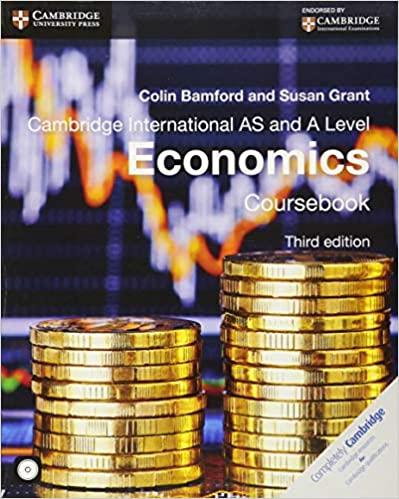a. What evidence is there to indicate that the UK supermarket business is an oligopoly? What further
Question:
a. What evidence is there to indicate that the UK supermarket business is an oligopoly? What further evidence might you need to be more certain that this is the case?
b. Comment on the suggestion that Tesco’s position as price leader is being undermined.
c. Other than price cutting, analyse the ways in which the Big Four might restrict the growth of new entrants such as Aldi and Lidl.
d. Discuss the extent to which the stores wars described above is in the best interests of the UK consumers.
The supermarket business in the UK is dominated by the so-called ‘Big Four’. Their market shares in March 2014 are shown below:
Tesco .................. 28%
Asda ................... 19%
Sainsburys .......... 18%
Morrisons ........... 11%
Other established supermarkets, notably the Co-operative and Waitrose, are way behind with market shares of 5–6%. Over the year to March 2014, Tesco and Morrisons have lost out whilst the other two have hung on to retain or marginally increase their market share. UK supermarkets are in a fiercely competitive business. Since 2008, consumer spending on food has been cut mainly as a result of recession. At the same time, established supermarkets have faced a new challenge from German-owned discounters Aldi and Lidl. When they first entered the market a few years ago, they had a ‘no-frills’ image and often sold products that were unknown to UK consumers. That has now changed. Both have expanded their market shares in the last year, notably Aldi which has now around 4% of the market. They have also begun to stock new products that have appeal to a wider spectrum of customers. The response of the Big Four has been to embark on a vicious no holds barred price war.
Recently:
■ Asda announced at the end of 2013 that it would spend £1bn cutting prices over the next five years.
■ Tesco then announced a £200m cut in its prices of core products, including fresh vegetables, and a scheme to reduce the price of petrol to its loyal customers.
■ Morrisons then followed a year of heavy losses by announcing that it was cutting its prices by £1bn over three years.
■ Sainsburys has remained committed to its ‘Brand Match’ policy of refunding to its customers any difference in its prices on selected items compared to competitors.
Tesco has until now been the price leader. Its profit margin is greater than its rivals although this has been shrinking. Whether it will be forced into taking further action on price is by no means clear. It could well be that the price-cutting campaigns that have been launched are a battle that none of the Big Four can win. Only time will tell.
Step by Step Answer:

Cambridge International AS And A Level Economics Coursebook
ISBN: 9781107679511
3rd Edition
Authors: Colin Bamford, Susan Grant




